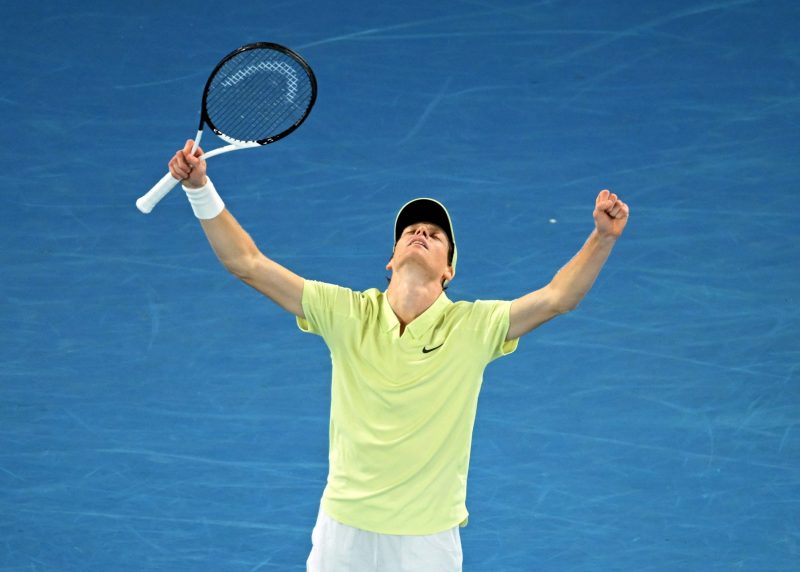Nobody in men’s tennis has an answer for Jannik Sinner at the moment.
The 23-year old Italian cruised to his second straight Australian Open title on Sunday and third major overall, beating world No. 2 Alexander Zverev 6-3, 7-6, 6-3 in a disappointingly one-sided final.
Sinner, who went 73-6 last year with eight ATP trophies, picked up right where he left off in Australia and dropped just two sets en route to the title.
Though Sunday’s final had the veneer of competitiveness at times, the reality is that Sinner does everything better than Zverev on a tennis court except serve – and even there, it’s a pretty even battle these days.
But that’s not just a Zverev issue. Sinner has spent the past year picking apart the top players one by one with his arsenal of ground strokes, which match supreme power with Novak Djokovic-like consistency, and elite movement around the court.
At the moment, Sinner doesn’t really have a weakness for opponents to exploit. They kind of have to hope he has a bad day – and he wasn’t in that mood over the past two weeks in Australia.
How it happened
There really wasn’t much drama in this one, nor were there a lot of spellbinding rallies. It was mostly meat-and-potatoes baseline tennis, and it generally didn’t go well for Zverev on the handful of occasions he tried to force the issue by coming to net.
Unsurprisingly, Sinner’s bigger, penetrating ball put him in position to control the forehand-to-forehand exchanges. But Zverev’s backhand, which is typically his best shot, also let him down too many times with 11 unforced errors in the second set when he needed to make his push.
Despite earning no break point chances in the entire match, Zverev perhaps had an opportunity in the tiebreaker to even things up and test Sinner’s fitness and nerve over a marathon match. But serving at 4-4 in the tiebreak, Zverev suffered a stroke of bad luck: Sinner’s inside-out forehand from the middle of the court clipped the top of the tape and dropped dead over the net, giving Zverev no chance to hit the ball. Sinner won his next two service points to close out the set and take command of the match.
Zverev’s energy dropped precipitously in the third set, and he was broken at 2-3 to essentially concede the title. It’s unclear whether that was resignation or the effect of his type-1 diabetes, which he has had to manage throughout his career. Zverev was seen twice during changeovers injecting himself with medicine to regulate his blood sugar. Zverev also seemed to be upset at various points in the match with the tension in his racket strings.
Sinner finished the match with a plus-5 winner-to-error ratio, while Zverev was minus-20.
What it means
With Sinner rolling like this, it seems at the moment that only Carlos Alcaraz can consistently push him head-to-head. Their rivalry stands at 6-4 in favor of Alcaraz, and Alcaraz has four Grand Slam titles to Sinner’s three.
However, there’s been a huge gulf between them over the last year when it comes to consistency over the course of the season. Alcaraz, who lost to Djokovic in the quarterfinals of this tournament, took several bad early-round losses over the last year while Sinner only lost to highly-ranked players (including three times to Alcaraz).
Their race for Grand Slam titles will be fascinating to watch over the coming years – but also alarming for the players in their late 20s like Zverev who have seen their generation underperform on the biggest stages.
Zverev, who has 23 ATP titles, is arguably the best player in the history of men’s tennis without a major. This was his third loss in a final, and it’s unclear where he goes from here. Zverev had complete control of the 2020 U.S. Open final against Dominic Thiem before falling apart and losing in a fifth-set tiebreaker, and last year he was ahead two sets to one on Alcaraz at Roland Garros before losing.
This match won’t leave Zverev with what-ifs, but where does he go from here knowing that the young guys are only getting better? The scar tissue seems to be accumulating.
Sinner, meanwhile, will have his biggest upcoming battle with WADA – the World Anti-Doping Agency. A little less than a year ago, he tested positive for traces of a steroid but was allowed to continue competing by the International Tennis Integrity Agency as an investigation took place.
Sinner and his team attributed the positive test to an over-the-counter spray available in Italy that contains the banned substance clostebol, which Sinner’s trainer had used to treat a cut on his hand. Sinner successfully argued to the ITIA that the substance entered his system by the trainer’s hand contact with lesions on his skin.
WADA, however, has pushed for Sinner to receive at least a one-year ban as punishment. Sinner now faces an April hearing in front of the Court of Arbitration for Sport. That leaves open the possibility Sinner could miss Grand Slams this summer.
(This story was updated to add a video.)
